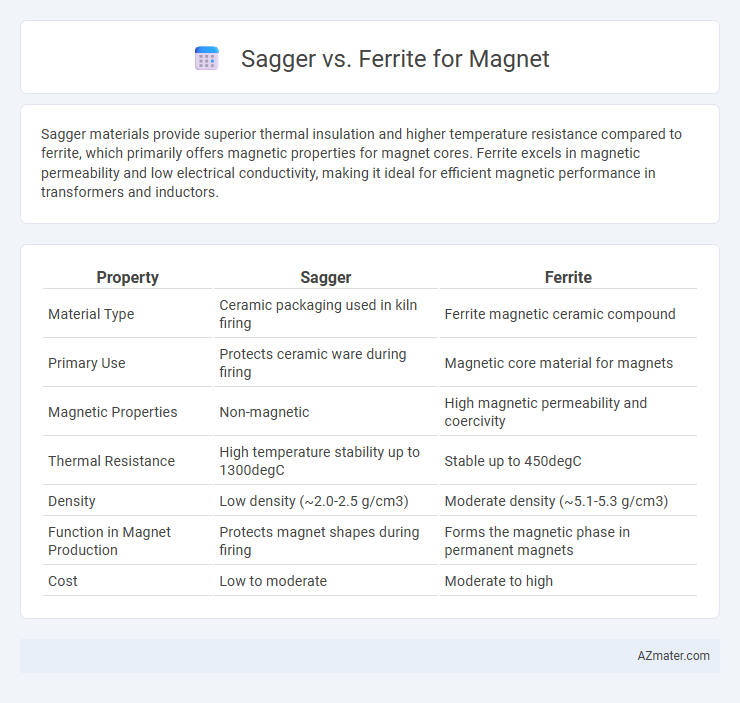Sagger materials provide superior thermal insulation and higher temperature resistance compared to ferrite, which primarily offers magnetic properties for magnet cores. Ferrite excels in magnetic permeability and low electrical conductivity, making it ideal for efficient magnetic performance in transformers and inductors.
Table of Comparison
| Property | Sagger | Ferrite |
|---|---|---|
| Material Type | Ceramic packaging used in kiln firing | Ferrite magnetic ceramic compound |
| Primary Use | Protects ceramic ware during firing | Magnetic core material for magnets |
| Magnetic Properties | Non-magnetic | High magnetic permeability and coercivity |
| Thermal Resistance | High temperature stability up to 1300degC | Stable up to 450degC |
| Density | Low density (~2.0-2.5 g/cm3) | Moderate density (~5.1-5.3 g/cm3) |
| Function in Magnet Production | Protects magnet shapes during firing | Forms the magnetic phase in permanent magnets |
| Cost | Low to moderate | Moderate to high |
Introduction to Sagger and Ferrite in Magnet Production
Sagger is a protective ceramic container used in high-temperature magnet production processes to shield ferrite powders from contamination and maintain uniform temperature distribution. Ferrite, a ceramic compound composed of iron oxide mixed with metallic elements like barium or strontium, forms the core magnetic material due to its excellent magnetic properties and cost-effectiveness. In magnet manufacturing, saggers ensure the integrity and quality of ferrite magnets by preventing exposure to atmosphere during sintering, leading to enhanced magnetic performance.
Understanding Sagger: Definition and Role in Magnet Manufacturing
Sagger is a refractory ceramic container used in magnet manufacturing to protect magnets during high-temperature sintering processes by preventing contamination and deformation. It provides a controlled environment, ensuring uniform heat distribution and preserving the magnetic properties essential for performance. Unlike ferrite, which is a magnetic material used in the magnet itself, sagger serves as a crucial protective tool in the production phase rather than the magnetic function.
Ferrite Magnets: Characteristics and Composition
Ferrite magnets, composed primarily of iron oxide and barium or strontium carbonate, offer high electrical resistance and excellent corrosion resistance, making them ideal for industrial applications. Their granular ceramic structure provides stable magnetic properties with moderate energy product and low cost compared to rare-earth magnets. Ferrite magnets maintain performance in high temperatures up to 250degC, ensuring reliability in motors, sensors, and magnetic separators.
Key Differences: Sagger vs Ferrite in Magnet Processes
Sagger and ferrite play distinct roles in magnet manufacturing, where sagger serves as a protective container during high-temperature sintering to prevent contamination and maintain dimensional integrity. Ferrite refers to the magnetic ceramic material composed primarily of iron oxide mixed with other metal oxides, forming the functional magnetic core. Key differences lie in their purpose--saggers ensure quality control during processing, while ferrites define the magnetic properties essential for applications in electronics, motors, and transformers.
Material Properties Comparison: Sagger vs Ferrite
Sagger and ferrite materials differ significantly in magnetic permeability and thermal stability, with ferrite exhibiting higher magnetic permeability and superior resistance to temperature-induced demagnetization, making it ideal for high-frequency applications. Saggers, typically composed of refractory ceramics, offer excellent thermal shock resistance and structural integrity but lack the magnetic properties required for effective magnet performance. Ferrite's lower density and cost-efficiency combined with its robust magnetic saturation and coercivity make it preferable for permanent magnet manufacturing compared to sagger materials primarily used in protective kiln furniture applications.
Manufacturing Processes: How Sagger and Ferrite Interact
In magnet manufacturing, sagger serves as a protective ceramic container that houses ferrite magnets during high-temperature firing, preventing contamination and deformation. The interaction between sagger and ferrite is crucial: sagger materials must withstand thermal expansion and chemical inertness to avoid affecting the ferrite's magnetic properties. Optimizing this interface enhances product quality by maintaining ferrite's microstructure integrity and magnetic performance throughout the sintering process.
Cost Implications of Using Sagger vs Ferrite
Sagger materials, typically composed of inexpensive refractory clays, offer a cost-effective solution for protecting ferrite magnets during high-temperature processes, whereas ferrite magnets themselves incur higher raw material and manufacturing costs due to their ceramic composition and magnetic properties. Using saggers can reduce expenses related to magnet damage and replacements, decreasing overall production costs despite the initial investment in sagger fabrication. Companies often balance the lower upfront cost of saggers against the durability and efficiency of ferrite magnets to optimize budget and performance in industrial applications.
Durability and Longevity: Sagger vs Ferrite in Magnetic Applications
Ferrite magnets offer superior durability and longevity compared to sagger materials due to their inherent resistance to corrosion, high temperature stability, and mechanical robustness. Sagger, typically used as a ceramic container in firing processes, lacks the magnetic properties and long-term structural integrity required for enduring magnetic applications. Ferrite's stable magnetic performance over extended periods makes it the preferred choice for durable and long-lasting magnet solutions.
Environmental Impact: Sagger vs Ferrite in the Magnet Industry
Sagger and ferrite materials have distinct environmental impacts within the magnet industry, with ferrite magnets being more eco-friendly due to their composition of abundant, non-toxic iron oxide and strontium or barium carbonate. Saggers, typically made from refractory materials used in kiln linings during magnet production, involve high energy consumption and generate more waste due to their limited recyclability and frequent replacement. The adoption of ferrite magnets reduces carbon footprints and hazardous waste, making them a preferred sustainable option in magnet manufacturing processes.
Future Trends: Innovations in Sagger and Ferrite for Magnet Production
Innovations in sagger materials and ferrite compositions are driving enhanced efficiency and sustainability in magnet production, with nano-structured ferrites offering superior magnetic properties and increased thermal stability. Advanced sagger designs utilizing high-purity, corrosion-resistant ceramics enable precise atmosphere control during sintering, reducing defects and improving magnetic performance. Future trends emphasize integrating smart manufacturing techniques and eco-friendly materials to optimize cost-effectiveness and environmental impact in ferrite magnet production.

Infographic: Sagger vs Ferrite for Magnet
 azmater.com
azmater.com